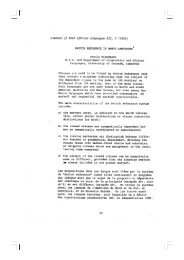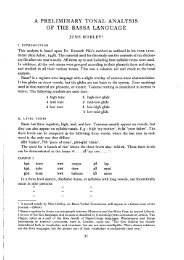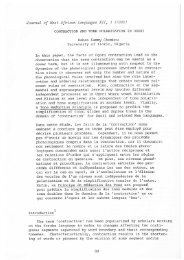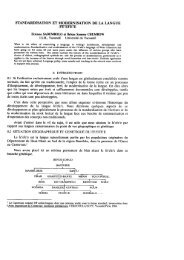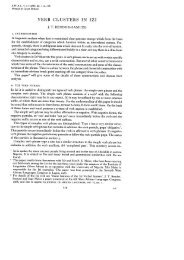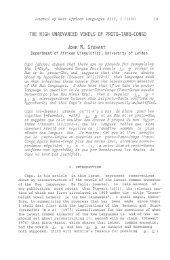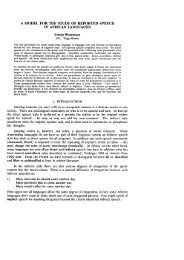The floating low tone in Bantu - Journal of West African Languages
The floating low tone in Bantu - Journal of West African Languages
The floating low tone in Bantu - Journal of West African Languages
You also want an ePaper? Increase the reach of your titles
YUMPU automatically turns print PDFs into web optimized ePapers that Google loves.
12 <strong>Journal</strong> <strong>of</strong> <strong>West</strong> <strong>African</strong> <strong>Languages</strong> XXXI.1 (2004)<br />
It is important to note that the contour formation does not only occur on affixes<br />
but also on root <strong>in</strong>itial syllables as illustrated by the data <strong>in</strong> 12 be<strong>low</strong> (nouns are<br />
chosen from class 1a).<br />
(12) a. (i) /fa + kar/ [fakar] give a r<strong>in</strong>g<br />
(ii) / fa + lm / [falm] give Lum (female name)<br />
HTS<br />
SR<br />
b. fa karˆ fakar [fakar]<br />
H L H L<br />
Hav<strong>in</strong>g identified and solved the problem posed by HTS <strong>in</strong> Bafut let us exam<strong>in</strong>e<br />
the implications <strong>of</strong> this analysis on some aspects <strong>of</strong> the phonology <strong>of</strong> Bafut.<br />
4. IMPLICATIONS<br />
<strong>The</strong> analysis presented above leads us to the conclusion that the <strong>float<strong>in</strong>g</strong> lexical<br />
<strong>tone</strong> postulated for class 1a nouns and the syllabic nasal postulated for noun roots <strong>in</strong><br />
<strong>in</strong>itial position no longer have the status <strong>of</strong> nom<strong>in</strong>al class prefixes. This is because<br />
unlike the other classes (1b, 2, 3a, 5, 6, 7, 8 and 19) that have different nom<strong>in</strong>al<br />
prefixes as one moves from s<strong>in</strong>gular to plural, neither the <strong>float<strong>in</strong>g</strong> <strong>tone</strong> <strong>of</strong> class 1a nor<br />
the <strong>in</strong>itial nasal <strong>of</strong> class 3b ever gets replaced by the plural nom<strong>in</strong>al prefix (cf section<br />
1).<br />
By say<strong>in</strong>g this does not <strong>in</strong> anyway refute the fact that these segments (the <strong>float<strong>in</strong>g</strong><br />
<strong>tone</strong> and syllabic nasals) are remnants <strong>of</strong> noun class prefixes. <strong>The</strong>re is every reason to<br />
believe them so. For example, the fact that class 1b nouns do not have any evidence <strong>of</strong><br />
the <strong>float<strong>in</strong>g</strong> <strong>tone</strong> when its overt prefix is replaced by the class 2 prefix <strong>in</strong> the plural<br />
form is testimony <strong>of</strong> this. Also, the fact that the Proto <strong>Bantu</strong> prefix for class 3 is mogives<br />
us reasons to believe that the nasal should be a remnant <strong>of</strong> this class prefix after a<br />
historical vowel deletion.<br />
However, s<strong>in</strong>ce the <strong>float<strong>in</strong>g</strong> class 1a <strong>tone</strong> is noticed when the class 2 prefix is<br />
affixed to the nouns <strong>of</strong> this class; the fact that the class 3b prefix is not replaced <strong>in</strong><br />
class 6, suggest, as Leroy (1977) notes, that a k<strong>in</strong>d <strong>of</strong> fusion process has taken place<br />
between the nom<strong>in</strong>al prefix and the root.<br />
Another significant implication <strong>of</strong> this analysis is the fact that noun class prefixes<br />
or the negative marker t- <strong>in</strong> Bafut is not <strong>low</strong> <strong>tone</strong>d as earlier works on the language<br />
have suggested, but <strong>tone</strong>less.



